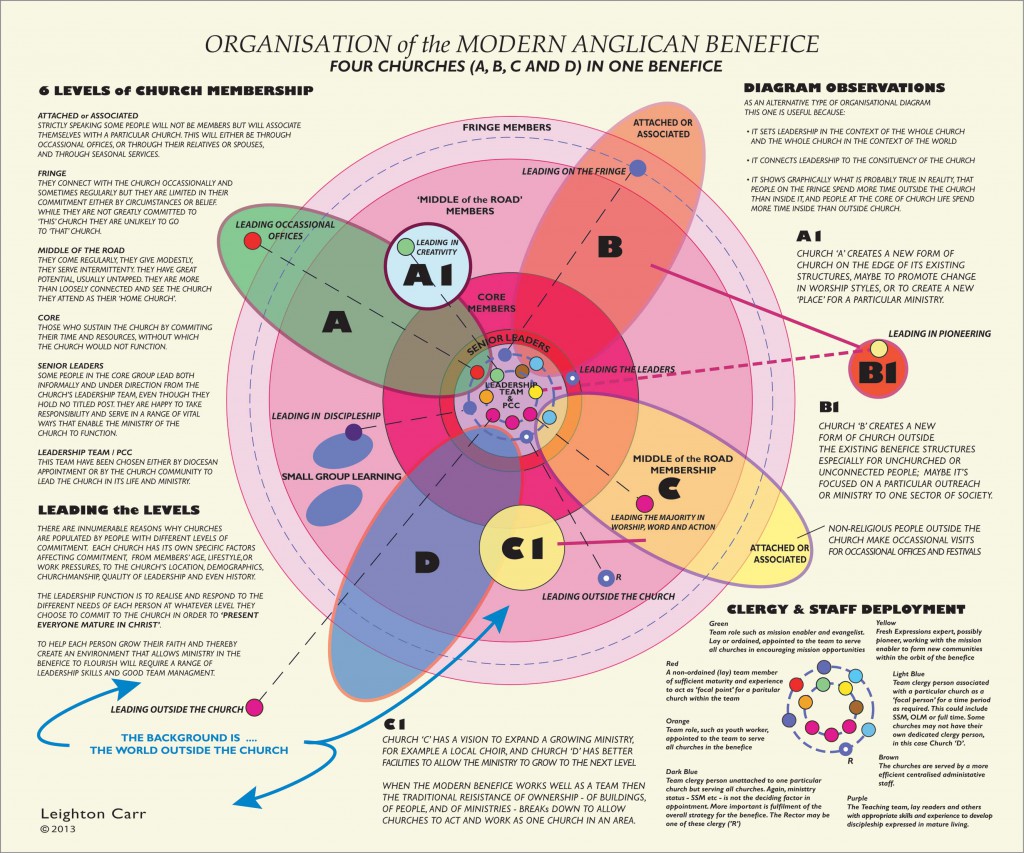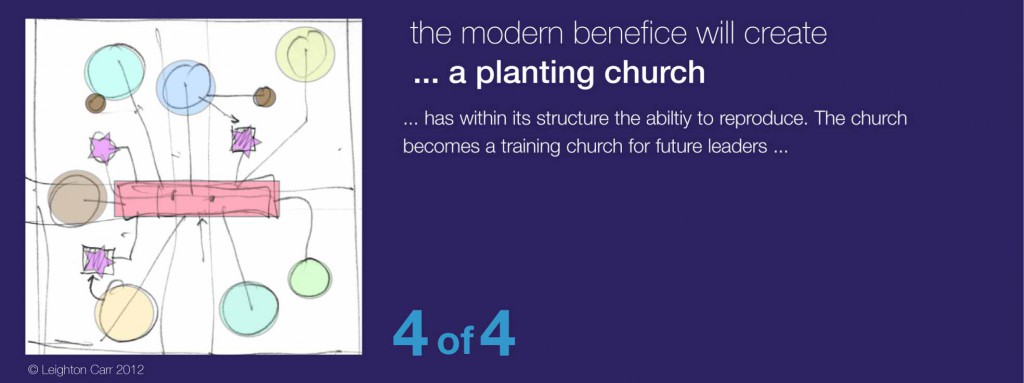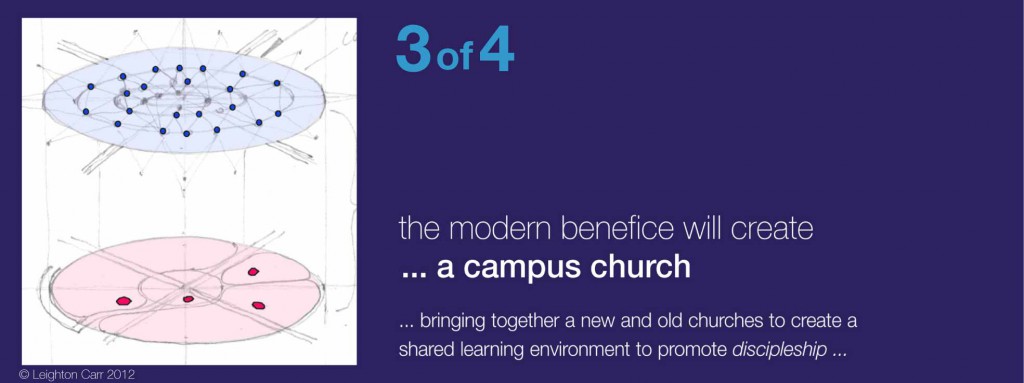Here’s an opening line to a conversation you never hear.\r\n\r\n“You can have your church buildings, or you can have a vicar, but you can’t have both”\r\n\r\nWe’re in a strange world where it’s easier to remove clergy than sell buildings. Two reasons for this immediately come to mind. First, there’s a belief that keeping the buildings (up)together keeps the congregation together, and this combination of buildings and people IS the church. Second, it’s simply easier for a diocese to reorganise to reduce staff than to sell assets. Presumably this is done in the hope that one day effective leadership will grow the church back to full occupancy and full staff numbers.\r\n\r\nBut as my bishop says, the first task of leadership is to define reality.\r\n\r\nIf there’s a small church, getting smaller, where no-one has come to faith for a decade, and without the income to support the buildings let alone a full time member of the clergy, then something has to give.\r\n\r\nIt’s reality.\r\n\r\nBut of course a small church, like any church, wants it all. It’s had it in the past, and in it’s own collective conciousness the past is the model for the future.\r\n\r\nBut wouldn’t it be a great conversation starter, in answer to the demand for a new vicar, to offer one or the other, the buildings or the staff?\r\n\r\nIt’ll never happen of course, but if it did I suspect the conversation on its own might start to radically redefine a church.
Category: church management
Five-fold Puzzle
Over the weekend I heard yet another sermon on the five-fold ministries of Ephesians 4.
\n
Apostle. Prophet. Evangelist. Pastor. Teacher.
\n
That’s four, five times this year?
\n
It seems to be common currency in the church at the moment, like the theme of ‘discipleship’. And like the theme of discipleship, preachers and teachers aren’t going deeper and either asking difficult questions or explaining in detail what they mean.
\n
For example, here’s something I’ve never heard preachers discuss.
\n
- \n
- How are these five gifts to be distributed within the church?
\n
\n
There’s plenty of talk about what these gifts are for, or how they work, but no sense of whether everyone should expect to use one or more of these gifts in the church.
\n
For example, while it’s possible that everyone may be gifted in one or more of these five-fold ministries, it’s by no means obvious from scripture that that is the case. But if these gifts aren’t for everyone – why not?
\n
So what is the premise of the sermon? Is it really a sermon about about church organisation?
\n
Again, that is an angle I’ve never heard expounded in detail. Why isn’t the church isn’t organised to allow these gifts to be used appropriately? In fact, some churches are organised specifically to exclude some people from certain gifts because of their gender. Some are excluded by their age. Some by their education. Some by common sense (how many Apostles can one church take!)
\n
Anyway, while this puzzles me every time I hear the sermon it troubles hardly any of the churches in my chosen denomination. As long we have a warden, a treasurer, a secretary and hopefully at least a part of a vicar, we’ll be OK.
\n
Although that’s getting harder too.
\n
Kill it off?
There are churches that are dying. By their own measures they are no longer viable, and by New Testament measures they are no longer Biblical.
\n
So what’s the best thing to do? Kill them off … or give them an injection of sustaining attention?
\n
In business, whole companies and whole departments regularly get culled as part of the shaping and pruning of the company/industry/sector. It’s not unusual, and some people are naturals when it comes to making the difficult decision to close something down. In fact, it’s an essential skill of both leadership and management. Kevin Kelly, guru of the digital age, in his book Out of Control says this:
\n
“It is generally easier to kill an organisation than change it substantially. Organisations by design are not made to adapt … beyond a certain point. Beyond this point it’s much easier to kill them off and start a new one … than it is to change them”
\n
(check out Kevin Kelly on his blog, or his discussion on the future of the internet on TED)
\n
But the church is different.
\n
The church by design was made to grow – continually. What it’s designer had in mind was more of a family than an organisation, with the inherent growth of reproduction built into it’s design. Kelly’s analysis doesn’t apply to a family. The church was meant to be a family that adapts – continually.
\n
So how can individual churches be dying?
\n
Because we turn them from families into organisations made in our own image – and Kelly’s analysis does apply to organisations, “its generally easier to kill an organisation than the change it substantially”.
\n
So sometimes we are faced with a choice. We may have to kill off the organisation to rediscover the family. If we don’t, in some places we will guarantee losing both.
\n
But really, who has the courage for that?
\n
Junior leaders in Senior posts
There’s a conundrum built into the process of renewing small Church of England congregations in urban and suburban areas. It’s centred on inexperience verses experienced leadership.\r\n\r\nWhen Curates finish their training they need to move to manageable congregations as a Post of First Responsibility.\r\n\r\nLarge churches are inappropriate environments for inexperienced incumbents. There’s to much at stake. Which leaves small churches. To be specific, this year’s curates have been advised that a an appropriate church for a first post is not more than 140 people give or take.\r\n\r\nBut smaller churches often have inherent problems such as …\r\n
- \r\n
- Few resources and a weak asset base …
- Debts, bad buildings and other liabilities
- An over-stretched but disillusioned minority keeping the church alive
- A demanding uncommitted congregation with unrealistic expectations
- A shortage of trained lay people and very few competent ministries
- Power problems, authority issues and personality clashes
- Unwillingness of the diocese to fund small failing churches
\r\n
\r\n
\r\n
\r\n
\r\n
\r\n
\r\n
\r\nIs this a job for a newly trained incumbent fresh from a curacy? For some characters maybe yes, they would thrive on this, but they are probably in the minority. What many of these churches really require is a more experienced person to guide them into renewal and make them effective. Someone who already has experience of leading congregations into growth, dealing with difficult characters, used to backing themselves in a conflict, able to build trust through times of hardship.\r\n\r\nBut here is the second problem. Small churches don’t attract the best and most experienced clergy.\r\n\r\nThis leadership conundrum raises two questions:\r\n
- \r\n
- how do small churches obtain the right person to bring renewal?
- where should new incumbents work if they are to become effective leaders and not be overwhelmed?
\r\n
\r\n
\r\nThe team ministry may offer a solution. Rather than being seen only as a way of saving salaries, one of the strengths of the team ministry is that it offers scope for involvement of clergy of various levels of expertise and experience. Large churches know this already and often they operate as a collection of ministries under the banner of a church rather than a benefice.\r\n\r\n(PS Is this only specific to urban churches? Possibly not, but different factors affect rural churches and chaplaincies)
Crossing the Aisle
A retail company wanted to kick-start its expansion by trying to tempt people to ‘cross the aisle’ in its stores from food to clothing .\r\n\r\nAfter some low achieving sales figures they commissioned some research into why this wasn’t working. The research showed that people didn’t want to cross the aisle, and it was a wasted effort trying to get people to do what they were never going to do.\r\n\r\nInstead the research discovered that people were happy to buy both food and clothing from the company but they wanted more clarity. The store moved to a different strategy where they separated products into different buildings, a clearly differentiated shopping experience but still the same brand. Growth followed.\r\n\r\nIt turns out that the company had just not understood the buying preferences of their customers. What was convenient for the company (doubling up on existing facilities, maximising resources) was not clear for the customer.\r\n\r\nUp-selling and cross-selling are well tried methods of increasing sales success but we should never loose sight of the need to investigate more radical options and to invest in where the growth really is and not where we hope it will be.\r\n\r\nApplying this to the question of church growth, this might explain why so many ventures started in church simply never take off. They draw too heavily on existing church resources, hoping to give the new clip-on ministry a boost from the momentum of the church as a whole. But along with drawing on resources the new ministry also draws on the culture of the church.\r\n\r\nIf the aim is to attract new people with a different profile – for example, a younger congregation – perhaps its better to put the new ministry at arms length from its parent, with greater independence to form its own identity.
Harvard Oxymoron – Creating an Organic Growth Machine
The Harvard Business Review audio library is a great resource and one I use regularly. Over the years it has been an invaluable source of ideas on organisations and personal development (explore at http://hbr.org/multimedia).
\n
But I was puzzled by the title of an interview given by Ken Favaro called ‘Creating an Organic Growth Machine’ (listen here – it’s worth it).
\n
The material was fine, and led me to rethink the way we could approach the funding of Pioneer Ministry in the Church of England (see the posts starting with Problems with Pioneers – Revex v Capex Funding). It was the oxymoron embedded in the title that caught my attention.
\n
Organic. Growth. Machine.
\n
Machines don’t grow organically. At least not the ones I’ve dealt with.
\n
For example, I analysed the shop floor layouts of the production lines at Transtec PLC in Coventry to see how we could reorganise the machines that produce aluminium engine parts for Jaguar cars. And another time I examined the machines that produce aluminium extrusions in a factory in Holland to ensure we could achieve the shapes and finishes we needed on a glazing contract.
\n
Obviously there was no possibility that these machines could exhibit any signs of organic growth.
\n
I knew what Ken Favaro was getting at. It was the idea that in some way we can combine two ideas into one image to give us a model for organisational development: combining the idea of a well ordered, machined process with the idea of organic growth in the natural world.
\n
The problem when we combine these two images is when we ‘drill down’ (there’s an irony, using an image borrowed from the oil and gas industry) into the metaphor. For example, we treat machines in a very different way from nature.
\n
- \n
- We tweak machines; we prune plants.
- We maintain machines; we nurture plants.
- We plan for obsolescence in machines; we allow for re-generation in plants.
- We drive machines for maximum consistent production: we tend plants for seasonal fruitfulness.
\n
\n
\n
\n
\n
There’s a “So what?” about all this? Does it matter? It’s just an idea.
\n
Well, I think it does. The images we overlay on our organisations can set the language, the pace, the values, the expectations, and the measures of success. Care is needed when handling powerful images, and it takes a high level of leadership skill to shape metaphors and images into a strong coherent narrative that doesn’t disenfranchise the true resource of the organisation – the people around whom it is built and sustained.
\n
Reorganisation of the Modern Anglican Benefice
It would be reasonable to assume that most Church of England clergy are uncomfortable with the idea of simply transferring business models and methods into the church.\r\n\r\nAs the church wrestles with questions of long-term sustainability some new thinking about structures has to be carried out, and it is not enough to simply adopt a streamlined management plan from a profit-motivated organisation and hope that the Anglican church can adapt. For start, most corporate internal organisation charts don’t include the client; they focus instead only on the Team, which can be controlled, not the public, (and for public read ‘Ordinary Church Member’).\r\n\r\nIt was reflecting on this problem which led to the doodle which led to the diagram below. It proposes an alternative organisational diagram for the modern Church of England Benefice.\r\n\r\nFor a larger version for zooming in see here.\r\n\r\nOn the same subject see Models of the Successful Modern Church of England Benefice\r\n
The successful modern Church of England benefice 4 – Planting
The successful modern Church of England benefice is an organic, networked and campus church, created for growth and witness. It is the logical outworking of this new Anglican focus that the successful benefice will find opportunities to share its resources and experience and expertise with other churches and in other places. It will become a Planting church. At times this will mean offering help to Anglican and other churches experiencing difficulties, and at other times it will mean starting new ventures of different shapes and styles to meet particular needs and opportunities.\r\n\r\nThis is 4 of 4: to see the whole poster go here\r\n\r\nOr see each individual post here: 1-Organic 2-Networked 3-Campus\r\n\r\n
The successful modern Church of England benefice 3 – Campus
The successful modern benefice in the Church of England will need to become a Campus. This means it will draw together resources for teaching, mentoring, coaching and training, for the purpose of helping Christians deepen their discipleship and witness. Lay ministers will need to work in a more flexible way, working in teams, with each person working to their strength, be it research, writing, preaching, coaching. The Campus church will also attract external resources from outside the Anglican church – theologians and educators – as well as offer resources to all local colleges and schools (not only Church of England schools!) to build up the life of society as a whole.\r\n\r\nThis is 3 of 4: see the whole poster go here\r\n\r\nOr see each individual post here: 1-Organic 2-Networked 4-Planting\r\n
The successful modern Church of England benefice 2 – Networked
A successful modern Church of England benefice will need to be Networked. That is, it will need to work across churches of different styles, theology and history, and across parish boundaries. Networked churches will make the most of resources, limiting duplication to maximise effectiveness and sustainability. To create and environment for sustainable growth the successful benefice will draw on the expertise of many people wherever they are found, in Anglican churches and others.\r\n\r\nThis is two of four: see the whole poster go here\r\n\r\nOr see each individual post here: 1-Organic 3-Campus 4-Planting\r\n\r\n \r\n\r\n
\r\n\r\n
- The Networked Benefice


